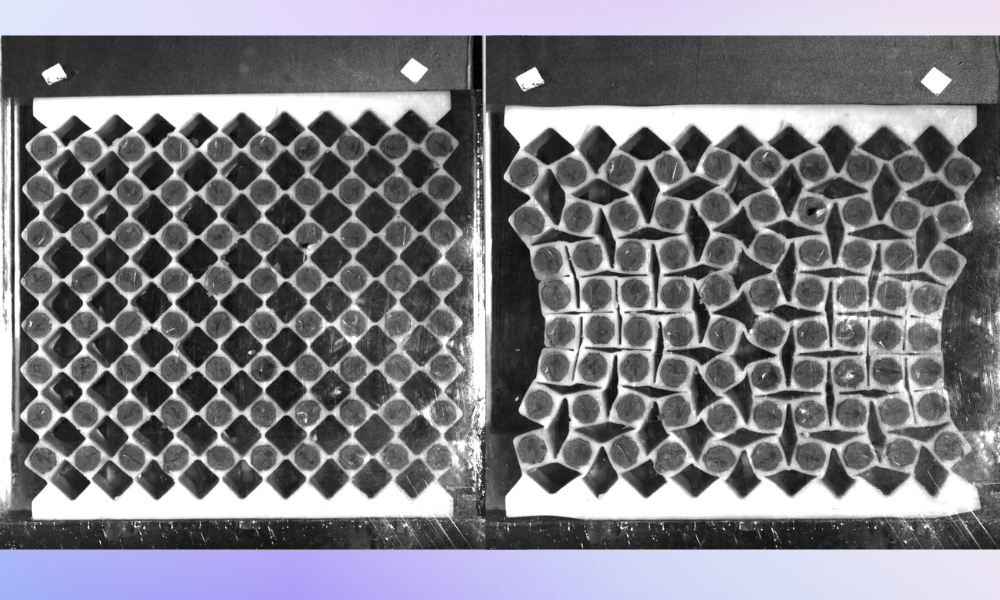Reviewed by Lexie CornerMay 7 2025
Researchers from Universidad Carlos III de Madrid (UC3M) and Harvard University have experimentally demonstrated that new artificial materials known as metamaterials, with magnetic properties, can have their mechanical and structural behavior reprogrammed without altering their composition. This breakthrough could drive innovations in fields such as soft robotics and biomedicine.
 Image of a press compressing magnetic metamaterials. Image Credit: Universidad Carlos III de Madrid
Image of a press compressing magnetic metamaterials. Image Credit: Universidad Carlos III de Madrid
The study explains how flexible magnets embedded within the structure of mechanical metamaterials can be used to reprogram their behavior.
What is innovative about our proposal is the incorporation of small flexible magnets integrated into a rotating rhomboid matrix that allows the stiffness and energy absorption capacity of the structure to be modified by simply changing the distribution of these magnets or applying an external magnetic field. This confers unique properties that are not present in conventional materials or in nature.
Daniel García-González, Study Author, Department of Continuum Mechanics and Structural Analysis, Universidad Carlos III de Madrid
“When we design new materials, we usually focus on their chemical composition and microstructure, but with metamaterials, we can also play with their internal geometry and spatial arrangement,” said Daniel García-González
This marks an important step toward creating reconfigurable mechanical structures for applications in aerospace, impact protection, and robotics. According to the researchers, the potential uses for this type of metastructure are vast.
From impact protection structures and adaptive components in soft robotics to intelligent shock-absorbing systems in exoskeletons. In the field of sports, they could be used to modify the mechanical response of a sports shoe sole by means of the interactions of the elements incorporated into it, making certain areas more flexible or rigid to improve the footfall of a person or a runner.
Josué Aranda Ruiz, Researcher, Department of Continuum Mechanics and Structural Analysis, Universidad Carlos III de Madrid
“Innovative possibilities are also opening up in biomedicine. For example, we could introduce modifications of these structures in an obstructed blood vessel and, by applying an external magnetic field, expand the matrix to unblock it,” pointed out Ruiz.
Researchers from Harvard and UC3M conducted the study by analyzing a range of materials and examining how their behavior changed based on magnetic orientation.
They explored how factors such as magnet placement, residual magnetization, and stiffness affected the static and dynamic responses of the metamaterial. The results showed that simply adjusting the orientation of the magnets could significantly alter the material’s performance. They also evaluated how these materials could be scaled up for use in dynamic impact tests.
“By modifying the position of the magnets to modulate the magnetic interaction between them, we can achieve completely different behaviors in the material,” said Carlos Pérez-García, a researcher in UC3M’s Department of Continuum Mechanics and Structural Analysis.
The project was supported by Spain’s Ministry of Science and Innovation and the European Research Council’s 4D-BIOMAP initiative, part of the Horizon 2020 programme. It also contributes to ongoing technology transfer efforts in soft robotics with the company Monodon (Navantia).
🔬 Metamateriales magnéticos reprogramables: el futuro de la robótica y la biomedicina
Video Credit: Universidad Carlos III de Madrid
Journal Reference:
Perez‐Garcia, C., et al. (2025) Reprogrammable Mechanical Metamaterials via Passive and Active Magnetic Interactions. Advanced Materials. doi.org/10.1002/adma.202412353.